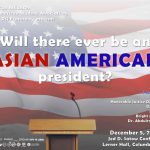Dear Paul Taylor and Dr. Mark Lopez,
We are writing on behalf of the Asian American Pacific Islander Policy and Research Consortium (AAPIPRC), a national organization of four university-based Asian American research centers. [i] We respectfully submit this response to the Pew Research Center’s recent report, The Rise of Asian Americans. Pew has assembled U.S. Census Bureau and government economic data, developing a detailed survey questionnaire, and conducting extensive telephone interviews with a national sample of 3,511 Asians. We acknowledge this is a major investment of Pew Research Center’s time and resources, and as a result has added to the publicly accessible information on the economic, social, and political situation of Asian Americans.
While there are merits to the Pew report, the selection of what information to present and highlight is highly biased, and the framing and interpretation of the analysis are incomplete and implicitly misleading and damaging for Asian American communities. We believe it is important to acknowledge the many accomplishments made by Asian Americans, but not at the expense of a fuller understanding of the diverse, complex and nuanced reality. The publication presents overly generalized descriptive and aggregate statistics, fails to critically explain the causes and limitations of observed outcomes, and falls short of examining tremendous and critical differences among Asian ethnic groups. We echo the comments by many Asian American scholars, advocates and lawmakers who point out how the study could lead policymakers, the media and the public to draw conclusions that reflect inaccurate stereotypes about Asian Americans being only a community with high levels of achievement and few challenges. There are many educational, economic, and health disparities, among others, facing our diverse communities. The selection of included populations leaves out some of the most distressed groups; consequently, the studied subjects are not representative.
As academic researchers, we understand the power and importance of quantitative analysis, but numbers are not just numbers, and they do not speak for themselves. They support a narrative through subjective decisions on topics, research design and methods, large frameworks to interpret results, and prioritizing which findings to highlight. We do not necessarily dispute the validity of many of Pew’s numbers, but we are deeply troubled by the emphasis that leaves the reader with a one-sided picture. A primary example revolves around the claim that “Asian Americans are the highest-income,” an assertion that is the lead line in the press release and rests on median household income. Pew is accurate in reporting the most recently available numbers from the American Community Survey ($66,000 for Asian Americans and $54,000 for non-Hispanic whites), but fails to fully adjust for two critical factors: one, Asian Americans tend to have larger households, and two, they are heavily concentrated in high-cost metropolitan areas.
Because of a larger household size, income does not go as far in covering expenses. Analytically, per capita income is a more realistic measure. Nationally, Asian Americans on the average have 93 cents to every dollar for non-Hispanic whites. High-cost metropolitan area puts a strain on available income, and the economy partially adjusts for this through offsetting higher wages (compensating differential). Analytically, it is more accurate to compare statistics at the metropolitan level. Over half of Asian Americans (54%) live in the ten metropolitan areas with the highest number of Asian Americans. In these areas, Asian Americans have 71 cents to every dollar for non-Hispanic whites. Clearly, the statistics on median household income and on adjusted per capita income portray Asian Americans very differently. Accounting for household size and location is very well known within the extensive literature on Asian Americans. While we realize that Pew acknowledges the potential role of household size and location, it nonetheless decided to spotlight unadjusted median household income. We believe that there are also other analytical flaws with the report because of Pew’s “spin”.
“Spinning” and selectively framing have serious implications. Pew examines race relations, and not surprisingly, the findings indicate inter-group tension. Unfortunately, the report does not adequately explain the factors and context that create the friction nor formulate effective solutions. Instead, it implicitly highlights the negatives. In examining perceived discrimination, the report does not integrate the research showing that Asian Americans are less likely to interpret, report and verbalize such acts, which can result in under-reporting. While the report sheds light on significant U.S. immigration trends and policies as they relate to Asians, it does so in a way that can adversely affect Asian-Latino relations. By highlighting the success of high achieving Asian immigrants, it shifts the immigration policy debates away from the concerns and contributions of Latino immigrants, especially the large numbers who are undocumented. This “model minority” framing can have a damaging impact on intergroup collaborations.
Again, we want to be balanced in our critique. We assume that Pew has made a useful contribution that brings much needed attention to the accomplishments of Asian Americans. At the same time, this has been counter balanced by the negatives. Our goal is to inform the public, decision makers and the media with accurate and well-rounded research that incorporates quantitative and qualitative methods, along with historical and humanistic accounts that give depth to the Asian American experience.
It is important, therefore, for Pew and other organizations to include researchers and analysts with greater knowledge of Asian American experiences. As you know, we are in the process of establishing an independent policy voice that more adequately represents Asian Americans. The Consortium is an initial effort to promote solid applied research. In this larger effort, we look forward to support and collaboration with Pew, along with other mainstream institutions.
We look forward to your response. Please send any correspondence to Professor Paul Ong (pmong@ucla.edu), who has agreed to coordinate AAPIPRC’s activities on this issue.
Sincerely yours,
Professor Joyce Moy, Executive Director
Asian American / Asian Research Institute at the City University of New York
Professor Lois Takahashi, Director
University of California Asian American Pacific Islander Policy Multi-campus Research Program
Professor Paul Watanabe, Director
Institute for Asian American Studies at the University of Massachusetts Boston
Professor David K. Yoo, Director
UCLA Asian American Studies Center
[i] This statement was prepared by Paul Ong, Melany De La Cruz, Chhandara Pech, Jonathan Ong and Don Nakanishi.








